The Angelbird Wings PX1 M.2 Adapter Review: Do M.2 SSDs Need Heatsinks?
by Billy Tallis on December 21, 2015 8:00 AM ESTRandom Write
The random write test runs for a total of 18 minutes, starting with a queue depth of 1 and doubling QD every three minutes. The test is limited to a 16GB portion of the drive and only that portion is pre-filled with data, so this test doesn't reflect the steady-state behavior of a full drive. The main scores are based on the average of QD1, QD2 and QD4 results as larger queue depths are rare for client workloads. A more detailed breakdown is graphed further down the page.
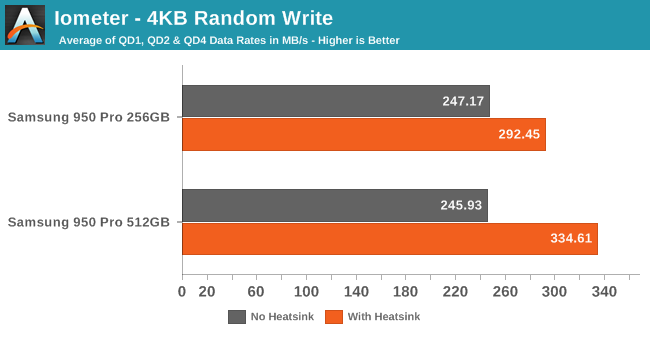
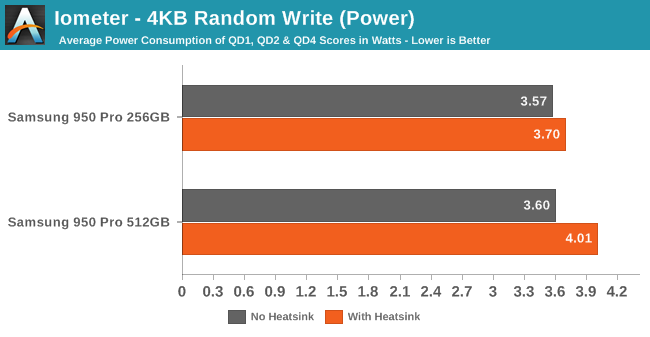
The heatsink allows the 950 Pro to reach significantly higher random write speeds, and enables the larger 512GB model to pull ahead of the 256GB model. Power comsumption increased slightly, but given the performance boost, efficiency is improved.
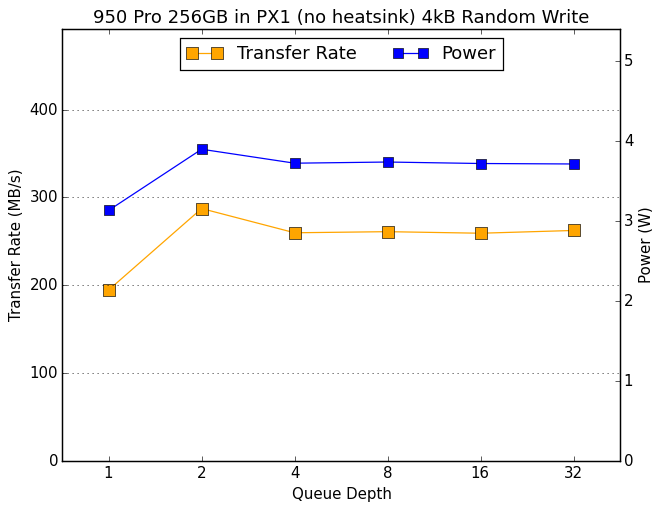 |
|||||||||
| 256GB no heatsink | 512GB no heatsink | ||||||||
| 256GB with heatsink | 512GB with heatsink | ||||||||
Without the heatsink, performance drops starting with a queue depth of 4, indicating that thermal throttling kicks in severely 6 to 9 minutes into the test. With the heatsink, we see that the 512GB model doesn't reach full performance until QD4.
Random Read
The timing and queue depth scaling for testing random reads are handled the same as for random writes, but reads are inherently faster and less power-hungry operations than writes for flash memory, so this is usually a less stressful test even when the drive's throughput is higher. The entire drive is filled before this test and the reads are not restricted to any portion of the drive.
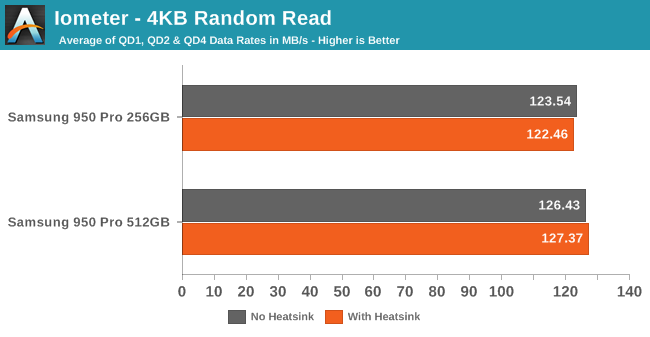
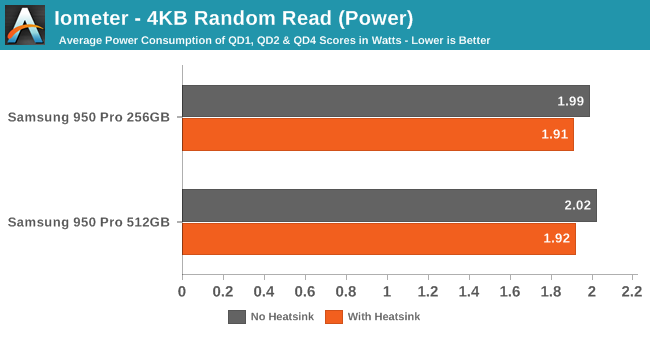
The performance for random reads is unaffected by the heatsink, but the lower operating temperature leads to less transistor leakage and thus slightly improved efficiency.
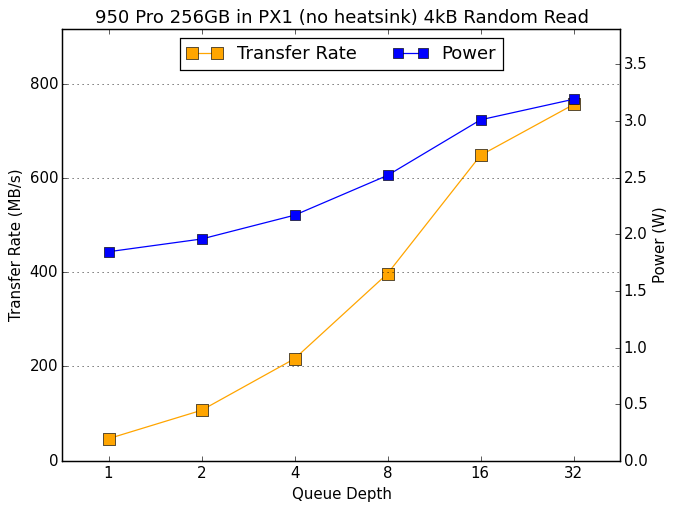 |
|||||||||
| 256GB no heatsink | 512GB no heatsink | ||||||||
| 256GB with heatsink | 512GB with heatsink | ||||||||
The heatsink produces no meaningful changes to the queue depth scaling behavior of random reads, further demonstrating that heat is not a problem for this test.










69 Comments
View All Comments
RealBeast - Monday, December 28, 2015 - link
"You know, since the LED's are white" Not really.Tell the Nobel committee about it. The 2014 prize in physics went to the blue boys -- red and green had been around for a while, and only they made white possible: http://www.nobelprize.org/nobel_prizes/physics/lau...
h4rm0ny - Tuesday, December 22, 2015 - link
Whilst agreeing with your point, you want either 'irrespective' or 'regardless', not "irregardless".More on topic I agree with both of you - I both recognize that what Teizo says about the customer base is probably true, and also agree with mooninite's despair that this is so. The two posts are not incompatible.
Murloc - Tuesday, December 22, 2015 - link
-less = withoutir- = in- before an 'r', the same as English un- (in- is latin, un- is germanic), it has a negative or privative force.
pick one but not both.
That said, RGB LEDs would make it cost too much, the price is already too high for consumers.
ddriver - Monday, December 21, 2015 - link
DO'H, it is not rocket science, if it overheads and throttles back as a result, then it obviously needs a heat sink.bug77 - Monday, December 21, 2015 - link
I think these tests answer another important question: when does it overheat.As it is, the drives only overheat during sustained write. This is far from unexpected, but at the same time it is reassuring to know it is the only scenario where a drive would throttle (as opposed to throttling under regular desktop usage).
ddriver - Monday, December 21, 2015 - link
But what about another important question, how much does it "hurt" to add a dollar worth of aluminum to improve a product worth several hundred dollars?bug77 - Monday, December 21, 2015 - link
If you have ever installed an M.2 drive, then you know there's not much space left for a heatsink. And you can only install it on one side. Even so, it's so close to the motherboard (and usually between PCIe slots) that if you don't have a hell of an airflow, it won't make much difference anyway.And that's only for desktops, good luck trying to fit a M.2 drive with a heatsink attached into an ultrabook.
ddriver - Monday, December 21, 2015 - link
You are very limited conceptually - it doesn't have to be a "radiator" type of heatsink, a flat piece of aluminum 2-3 mm thick would suffice. Heatsinks come in various shapes and sizes, not necessary the bulky, thick finned design.The SSD doesn't displace a lot of heat to begin with, but without a heatsink for that HEAT to SINK into the bare chip quickly runs out of thermal room.
Even if it still throttles, it will ramp the temp up slower as the heatsink will act as a buffer, and regardless of how little airflow it may have, a larger piece of aluminum will always displace much more heat than a tiny chip.
It will be slower to overheat and faster to cool, even in an ultrabook or tablet, and yes, with the kind of heatsink it merits it will have no trouble fitting into portable devices.
Judging by the performance regressions from adding a heatsink to the larger model, it would seem that engineers were well aware it throttles and have optimized the product for it, so taking care of the heat puts the device in a less than optimal standing. A firmware update should be enough to address this issue and eliminate any sort of performance regressions and actually improve it somewhat. Engineering a product which runs worse with better cooling - that's kind of an epic fail.
jjj - Monday, December 21, 2015 - link
Unless it detects benchmarks and lets the controller clock higher for better scores.If VW can do it , the possibility needs to be investigated elsewhere too.nathanddrews - Monday, December 21, 2015 - link
You know what this means, right? Next test: custom water blocks.